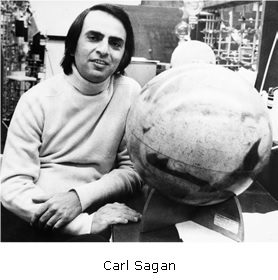Joseph likes Astronomy, History and Archaeology and they have been talking about Carl Edward Sagan, the American astronomer and science communicator who died on a day like today in 1996.
Joseph and The Grandma think that the best way to pay homage to Carl Sagan is talking about his life and his career.
Carl Edward Sagan (November 9, 1934-December 20, 1996) was an American astronomer, cosmologist, astrophysicist, astrobiologist, author, poet, and science communicator.
His best known scientific contribution is research on extraterrestrial life, including experimental demonstration of the production of amino acids from basic chemicals by radiation.
Sagan assembled the first physical messages sent into space: the Pioneer plaque and the Voyager Golden Record, universal messages that could potentially be understood by any extraterrestrial intelligence that might find them. Sagan argued the now-accepted hypothesis that the high surface temperatures of Venus can be attributed to and calculated using the greenhouse effect.
Initially an associate professor at Harvard and later at Cornell, from 1976 to his death, he was the David Duncan Professor of Astronomy and Space Sciences at the latter. Sagan published more than 600 scientific papers and articles and was author, co-author or editor of more than 20 books.
More information: Rolling Stones
He wrote many popular science books, such as The Dragons of Eden, Broca's Brain and Pale Blue Dot, and narrated and co-wrote the award-winning 1980 television series Cosmos: A Personal Voyage. The most widely watched series in the history of American public television, Cosmos has been seen by at least 500 million people across 60 different countries.
The book Cosmos was published to accompany the series. He also wrote the science fiction novel Contact, the basis for a 1997 film of the same name. His papers, containing 595,000 items, are archived at The Library of Congress.
Sagan advocated scientific skeptical inquiry and the scientific method, pioneered exobiology and promoted the Search for Extra-Terrestrial Intelligence (SETI). He spent most of his career as a professor of astronomy at Cornell University, where he directed the Laboratory for Planetary Studies.
Carl Sagan was born in Brooklyn, New York. His father, Samuel Sagan, was an immigrant garment worker from Kamianets-Podilskyi, then in the Russian Empire, in today's Ukraine. His mother, Rachel Molly Gruber, was a housewife from New York. Carl was named in honor of Rachel's biological mother, Chaiya Clara, in Sagan's words, the mother she never knew.
Sagan had lived in Bensonhurst, where he went to David A. Boody Junior High School. He had his bar mitzvah in Bensonhurst when he turned 13. The following year, 1948, his family moved to the nearby town of Rahway, New Jersey, for his father's work, where Sagan then entered Rahway High School. He graduated in 1951. Rahway was an older industrial town, and the Sagans were among its few Jewish families.
More information: Wired
Sagan attended the University of Chicago, which was one of the few colleges he applied to that would, despite his excellent high-school grades, consider admitting a 16-year-old. Its chancellor, Robert Maynard Hutchins, had recently retooled the undergraduate College of the University of Chicago into an ideal meritocracy built on Great Books, Socratic dialogue, comprehensive examinations and early entrance to college with no age requirement. The school also employed a number of the nation's leading scientists, including Enrico Fermi and Edward Teller, along with operating the famous Yerkes Observatory.
In 1980 Sagan co-wrote and narrated the award-winning 13-part PBS television series Cosmos: A Personal Voyage, which became the most widely watched series in the history of American public television until 1990. The show has been seen by at least 500 million people across 60 countries. The book, Cosmos, written by Sagan, was published to accompany the series.
Speaking about his activities in popularizing science, Sagan said that there were at least two reasons for scientists to share the purposes of science and its contemporary state. Simple self-interest was one: much of the funding for science came from the public, and the public therefore had the right to know how the money was being spent. If scientists increased public admiration for science, there was a good chance of having more public supporters. The other reason was the excitement of communicating one's own excitement about science to others.
After suffering from myelodysplasia for two years and receiving three bone marrow transplants from his sister, Sagan died from pneumonia at the age of 62, at the Fred Hutchinson Cancer Research Center in Seattle, Washington, on December 20, 1996. His burial took place at Lake View Cemetery in Ithaca, New York.
More information: Speakola
harmony with human ambition.
Carl Sagan


No comments:
Post a Comment